UPSC Exam > UPSC Notes > Current Affairs & Hindu Analysis: Daily, Weekly & Monthly > Geography: January 2023 UPSC Current Affairs
Geography: January 2023 UPSC Current Affairs | Current Affairs & Hindu Analysis: Daily, Weekly & Monthly PDF Download
Call For Permanent Cancellation Of Bauxite Mining Lease In Odisha
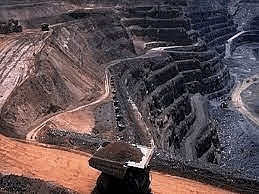 Why in the news?
Why in the news?
- Recently, it had been reported that a hearing had been scheduled by the Odisha State Pollution Control Board regarding mining at the Maliparvat mine in Koraput district.
- Residents of the area had been actively protesting against the reopening of the mine and had reached Bhubaneswar to protest against reopening the mine.
Who are the protesters?
- 19 villages under 4 Gram panchayats in Semiliguda block of Koraput district have submitted an objection to the secretary of the Odisha State PCB.
- They had previously sent individual and village-level objections to Hindalco's proposed plan of mining bauxite.
- The Maliparvat Surakhya Samiti (MPSS), a forum of villagers had been leading the movement.
Why are they protesting?
- In 2007, Hindalco was awarded the lease for the mining of bauxite at Maliparvat.
- The company had mentioned in its EIA report that there were no waterbodies in Maliparvat.
- However, a survey conducted by the MPSS discovered 36 perennial streams flowing down from the Maliparvat.
- These streams were a source of water for the villages nearby for irrigation, drinking, and household purposes.
- Prafulla Samantara, an activist and winner of the Goldman Environment Prize, alleged that the company had failed to carry out mining activities till 2011 when its environmental clearance expired.
- He added that the company had carried out illegal mining between 2012 and 2014 without renewing its environmental license.
- In the last year, the people of the area participated in 3 public hearings conducted by the Odisha State PCB and the district administration.
- Around 30 villages in the region have been protesting against the reopening as they believe that the hill is a sacred place where their deities Pakulidevi and Pathkanda reside.
What has the High Court ordered?
- A division bench of the Odisha High Court comprising Chief Justice Dr. S Murlidhar and Just. MS Raman had recently directed the Odisha State PCB to issue a fresh notice for the public hearing.
- The fresh hearing was to be chaired by the District Collector and include the Koraput District Judge and District Legal Services Authority as neutral observers.
- The meeting was to be fully videographed.
- The previous hearing had ended with accusations of violence and excessive use of force by the police against protestors.
Environmental Impact Assessment (EIA)
- It involves assessing the potential positive and negative environmental effects of a project or development while also taking into account related socio-economic, cultural, and human health effects.
- EIA is a tool used to evaluate a project's potential effects on the environment, economy, and society even in the pre-planning stage, allowing for the reduction of the negative effects.
Objectives
- Determining, foreseeing, and assessing the effects of development operations on the economy, the environment, and society.
- Supplying data on environmental effects for use in decision-making.
- Locating viable alternatives and mitigation measures, promoting ecologically sound and suitable growth.
- The various stages of the EIA include Screening, Scoping, Impact analysis, Mitigation, Reporting, Public hearing, Review of EIA, Decision-making, Post monitoring.
Manufactured Sand
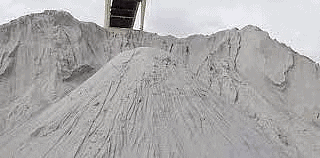 Why in News?
Why in News?
- Coal India Limited (CIL) is making headlines for its innovative solution to the sand shortage problem. The company is using crushed rock fines (crusher dust), sand from Overburden (OB) of coal mines and soil removed during opencast coal mining, to produce Manufactured Sand (M-Sand).
- This not only repurposes waste materials but also reduces the need for natural sand mining and creates an additional revenue stream for the company.
What are the Benefits of Manufactured Sand (M-Sand)?
- Cost-effectiveness: Using manufactured sand can be more cost-effective than using natural sand, as it can be produced in large quantities at a lower cost.
- Consistency: Manufactured sand can have a consistent grain size and shape, which can be beneficial for construction projects that require a specific type of sand.
- Environmental Benefits: Using manufactured sand can help to reduce the need for mining natural sand, which can have negative environmental impacts.
- Additionally, using the overburden from coal mines can help to repurpose materials that would otherwise be considered waste.
- Reduced Water Consumption: Using manufactured sand can help to reduce the amount of water required for construction projects, as it does not require washing before use.
- Other Benefits: Apart from commercial use, sand produced shall also be consumed for sand stowing in Underground Mines enhancing safety & conservation.
- Also, lesser Sand extraction from rivers will reduce erosion of channel bed & banks and protect water habitat.
What is the Status of Sand Mining in India?
- About:
- Sand is classified as a “minor mineral”, under The Mines and Minerals (Development and Regulations) Act, 1957 (MMDR Act) and administrative control over minor minerals vests with the State Governments.
- Rivers and coastal areas are the main sources of sand, and the demand for it has increased significantly in recent years due to the construction and infrastructure development boom in the country.
- The Ministry of Environment, Forests, and Climate Change (MoEFCC) has issued "Sustainable Sand Mining Management Guidelines 2016" to promote scientific sand mining and environmentally friendly management practices.
- Issues Related to Sand Mining in India:
- Environmental Degradation: Sand mining can lead to the destruction of habitats and ecosystems, as well as erosion of river banks and coastal areas.
- Water Scarcity: Sand mining can deplete the water table and reduce the availability of water for drinking and irrigation.
- For example, in the state of Rajasthan, sand mining has led to a decline in the water level of the Luni River, affecting the drinking water supply of nearby villages.
- Floods: Excessive sand mining can cause the riverbeds to become shallow, which can increase the risk of floods.
- For example, in the state of Bihar, sand mining has led to increased flooding in the Kosi River, causing damage to crops and property.
- Corruption: Sand mining is a highly profitable activity, and there have been instances of corruption and bribery in the allocation of mining leases and the enforcement of regulations.
Way Forward
- Sustainable Mining Practices: Sand mining can be carried out in an environmentally sustainable manner by using scientific methods and equipment that minimise damage to the environment.
- This could include the use of dredging and mining techniques that do not disturb the riverbeds, or the use of manufactured sand as an alternative to river sand.
- Strict Regulation and Enforcement: The government can regulate sand mining through legislation and enforce strict penalties for illegal mining.
- This can also include the formation of a regulatory body that monitors the mining activities and ensures compliance with the laws and regulations.
- Community Participation: Local communities can be involved in the decision-making process related to sand mining, which can help to address their concerns and ensure that their livelihoods are not adversely affected.
- Innovative Solutions: The government can explore innovative solutions to address the issues related to sand mining.
- For example, the use of drones and satellite imagery can be used to monitor mining activities, to detect and stop illegal mining.
Deep-Water Circulation
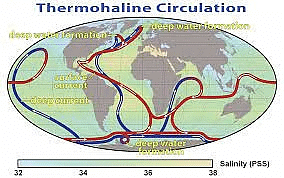
Why in News?
Recent studies have indicated that tectonically driven changes in the ocean gateways had a dramatic impact on the global overturning circulations.
What do the Latest Findings Suggest?
- Studies suggest that changes in ocean routes caused by tectonics, like the closing of the Central American Seaway, had a big effect on ocean circulation.
- Central American Seaway is a body of water that once separated North America from South America,
- These changes may have led to the creation of two distinct water bodies:
- Northern component water in the North Atlantic Ocean.
- Antarctic Bottom Water (AABW) in the Southern Ocean.
- Consequently, it is also hypothesised that there would have been large-scale changes in the Deep-Water Circulation (DWC) in the oceans across the world, impacting global climate and heat exchanges.
What is Deep Water Circulation (DWC)?
- About:
- It refers to the movement of water in the deep ocean. It is driven by the density differences between water masses caused by variations in temperature and salinity.
- In the Earth's polar regions ocean water gets very cold, forming sea ice. As a consequence, the surrounding seawater gets saltier, because when sea ice forms, the salt is left behind.
- As the seawater gets saltier, its density increases, and it starts to sink. Surface water is pulled in to replace the sinking water, which in turn eventually becomes cold and salty enough to sink.
- This creates a circulation pattern that is known as the thermohaline circulation.
- Significance:
- Heat Distribution: It helps to distribute heat around the globe, which helps to regulate the Earth's temperature and keep different regions from becoming too hot or too cold.
- Maintaining Carbon Dioxide Levels: It plays a critical role in controlling atmospheric carbon dioxide levels by helping to transport carbon from the surface to the deep ocean, where it can be stored for long periods of time.
- Shaping Ocean Currents: It is responsible for shaping the ocean's currents and the circulation patterns of the world's oceans.
- These currents in turn influence the marine ecosystem, weather patterns, and coastal regions.
- Maintaining Sea level: It also has an impact on sea level, as warm water is less dense than cold water, therefore it can also affect sea level by redistributing heat and thermal expansion.
- Deep-Water Circulations of the Indian Ocean:
- The Indian Ocean does not produce its own deep water, it only receives it from other sources such as the North Atlantic and Antarctic.
- The northern part of the Indian Ocean is located far away from the areas where deep water is formed and ocean routes, making it a good place to study the impact of ocean circulation changes.
- Studies have been done in the Indian Ocean to understand past deepwater circulation using records from iron-manganese crusts and authigenic neodymium isotope composition of sediment cores.
- These records have few limitations:
- Iron-manganese crusts are found at deeper depths and are only bathed by Antarctic Bottom Water (AABW), so they can only provide information about the history of AABW.
- Authigenic neodymium isotope records are only available from the Bay of Bengal region, but they are also not accurate as the Himalayan rivers that flow into the Bay bring in a lot of neodymium particulates which can interfere with the results.
- However, recently Scientists have generated an authigenic neodymium isotope record from the Arabian Sea and reconstructed the DWC record of the Indian Ocean for the period from 11.3 million years ago (Miocene era) to 1.98 million years ago (Pleistocene era).
Rare Earth Elements Discovered in Sweden
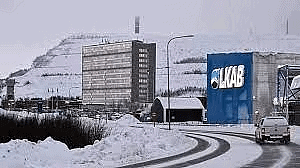
Why in News?
Recently, Sweden’s state-owned mining company LKAB has discovered Europe’s largest deposit of rare earth metals.
What is the Significance of the Discovery?
- The store, situated in Kiruna located in the northern region of Sweden, holds a stockpile of over 1 million metric tons of rare earth oxides.
- This discovery bolsters Europe's ambition to rely less on imported raw materials needed for the green transition.
- Currently, no rare earths are mined in Europe and it mostly imports them from other regions.
- According to a report in the BBC, 98% of rare earths used by the European Union (EU) were sent by China.
- The discovery can also prove to be a significant turning point not just for the EU but also for other western countries as they have been trying to reduce their reliance on China for the import of these rare earth elements.
What are Rare Earth Elements?
- About:
- They are a set of 17 metallic elements. These include the 15 lanthanides on the periodic table in addition to scandium and yttrium that show similar physical and chemical properties to the lanthanides.
- Significance:
- They are important in technologies of consumer electronics, computers and networks, communications, clean energy, advanced transportation, healthcare, environmental mitigation, and national defence, among others.
- Scandium is used in televisions and fluorescent lamps
- Yttrium is used in drugs to treat rheumatoid arthritis and cancer.
- Rare earth elements are also used in space shuttle components, jet engine turbines, and drones.
- Cerium, the most abundant rare earth element, is essential to NASA’s Space Shuttle Programme.
- Moreover, the push for switching from internal combustion cars to electric vehicles has also led to a rise in demand for rare earth.
- Monopoly of China:
- China has over time acquired global domination of rare earths, even at one point, it produced 90% of the rare earths the world needs.
- Today, however, it has come down to 60% and the remaining is produced by other countries, including the Quad (Australia, India, Japan and United States).
- Since 2010, when China curbed shipments of Rare Earths to Japan, the US, and Europe, production units have come up in Australia.
- Even so, the dominant share of processed Rare Earths lies with China.
- Rare Earth Elements in India:
- India has 6% of the world’s rare earth reserves, it only produces 1% of global output, and meets most of its requirements of such minerals from China.
- Indian Rare Earths Limited (IREL) is majorly responsible for mining and extraction of primary mineral that contains Rare Earth Elements: monazite beach sand, found in many coastal states.
- IREL’s prime focus is to provide thorium — extracted from monazite — to the Department of Atomic Energy.
Heat Dome
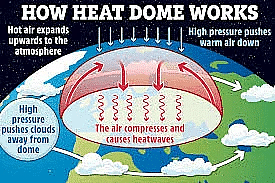
Why in News?
Several countries in Europe recorded their hottest January weather ever in 2023 with temperatures 10 to 20 degrees Celsius above average.
- These included Poland, Denmark, the Czech Republic, the Netherlands, Belarus, Lithuania and Latvia.
- Experts said that the continent is experiencing an extremely warm spell because of the formation of a heat dome over the region.
- In 2021, a heat dome formed over western Canada and the US, causing deadly heat waves.
- Another heat dome settled over the US in September 2022 and raised temperatures to a new high.
What is a Heat Dome and Heat Wave?
- Heat Dome:
- A heat dome occurs when an area of high-pressure traps warm air over a region, just like a lid on a pot, for an extended period of time.
- The longer that air remains trapped, the more the sun works to heat the air, producing warmer conditions with every passing day.
- Heat domes generally stay for a few days but sometimes they can extend up to weeks, which might cause deadly heat waves.
- Scientists suggest that any region of high pressure, whether a heat dome or not, forces air to sink and once it reaches the ground, it gets compressed and becomes even warmer.
- Moreover, when air sinks, it gets drier and further raises the temperature of the area.
- Heat Domes and the Jet Stream:
- The heat dome’s formation is related to the behaviour of the jet stream.
- Jet streams are relatively narrow bands of strong wind in the upper levels of the atmosphere
- The jet stream is believed to have a wave-like pattern that keeps moving from north to south and then north again.
- When these waves get bigger and elongated, they move slowly and sometimes can become stationary.
- This is when a high-pressure system gets stuck and leads to the occurrence of a heat dome.
- Although heat domes are likely to have always existed, researchers say that climate change may be making them more intense and longer.
- They suggest with the rising temperatures, it is expected that the jet stream will become more wavy and will have larger deviations, causing more frequent extreme heat events.
What are the Causes of Formation of Heat Dome?
- Change in Ocean Temperature: The phenomenon begins when there is a strong change (or gradient) in ocean temperatures.
- In the process known as convection, the gradient causes more warm air, heated by the ocean surface, to rise over the ocean surface.
- As prevailing winds move the hot air east, the northern shifts of the jet stream trap the air and move it toward land, where it sinks, resulting in heat waves.
- Change in Atmospheric Pressure: Heat waves begin when high pressure in the atmosphere moves in and pushes warm air toward the ground. This effect is fueled by heat rising from the ocean, creating an amplification loop.
- The high-pressure system pressing down on the ground expands vertically, forcing other weather systems to change course.
- It even minimizes wind and cloud cover, making the air more stifling.
- This is also why a heat wave parks itself over an area for several days or longer.
- Climate Change: The rising temperatures lead to hotter weather. Heat waves have been a regular phenomenon on land.
- However, global warming has caused them to be hotter with a longer duration and an increased frequency.
- Scientists studying the climate tend to agree that the heat waves occurring today are more likely to be a result of climate change for which humans are responsible.
Inner Core of the Earth
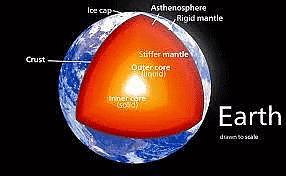 Why in News?
Why in News?
Recently, new research suggested that Earth's inner core has stopped spinning faster than its surface and might now be rotating slower than it.
What are the Highlights of the Research?
- Methodology:
- The research analyzed seismic waves from repeating earthquakes over the last six decades.
- By analysing changes in the time and propagation of these signals, they could estimate the rotation of the inner core, which is believed to move independently from the mantle and rest of the planet.
- Findings:
- The inner core started rotating slightly faster than the rest of the planet in the early 1970s. But it had been slowing down before coming in sync with Earth's rotation around 2009.
- There has been a "negative trend", meaning the inner core is now rotating slower than the surface. Next change may occur in the mid-2040s.
- The results seem to indicate that the Earth’s inner core changes its speed of rotation every 60-70 years on average.
- Significance:
- The Study can motivate some researchers to build and test models which treat the whole Earth as an integrated dynamic system.
- The slowdown could change how rapidly the entire planet spins, as well as influence how the core evolves with time.
How is the Earth’s Inner Core?
- About:
- It is the innermost layer of the Earth. It is a hot iron ball of the size of Pluto.
- The inner core is solid due to the pressure caused by the weight put on it by the Earth’s other top layers.
- It is distinct from the outer core, which is a liquid.
- Roughly 5,000 kilometers (3,100 miles) below the surface we live on, the inner core can spin independently because it floats in the liquid metal outer core.
- Radius:
- The inner core has an average radius of 1220 km.
- The boundary between the inner and outer cores is located at approximately 5150 km below the surface of the Earth.
- This boundary is called the Lehman Seismic Discontinuity.
- Temperature:
- Between 7,200–8,500ºF (4,000–4,700ºC).
- Properties:
- It is predicted to have very high thermal and electrical conductivity.
What are the Three Layers of Earth?
- Crust: This is the outside layer of the earth and is made of solid rock, mostly basalt and granite.
- Mantle: It lies below the crust and is up to 2900 km thick. It consists of hot, dense, iron and magnesium-rich solid rock.
- Core: It is the center of the earth and is made up of two parts: the liquid outer core and solid inner core. The outer core is made of nickel, iron and molten rock.
Cold Wave
 Why in News?
Why in News?
Delhi and other parts of northwest India have been reeling under a Cold Wave since the beginning of 2023.
- The lowest minimum temperature recorded this month was 1.9 degrees Celsius on January 8, the second-lowest minimum temperature in January in 15 years.
- Fog and low cloud coverage brought severe cold day conditions to the region, when temperatures remained below normal over parts of Delhi, Punjab, Haryana, Chandigarh, Himachal Pradesh, Rajasthan, Uttar Pradesh and Madhya Pradesh.
What Factors are Responsible for this Cold Wave?
- Large Scale Fog:
- One of the major factors contributing to colder than normal temperatures over north India in January 2023 is the large-scale fog cover, according to India Meteorological Department (IMD).
- Fog has been lasting for longer durations, preventing sunlight from reaching the surface and affecting the radiation balance. There is no heating in the day time, and then there is the impact of the night.
- Foggy Nights:
- Foggy or cloudy nights are usually associated with warmer nights, but if the fog remains for two or three days, cooling begins even at night.
- Light winds and high moisture near the land surface have been contributing to the formation of a blanket of fog over large swathes of the Indo-Gangetic plains in the morning.
- Westerly Winds:
- Since there has not been any significant impact of western disturbances over the region, cold northwesterly winds have also been contributing to low temperatures.
- Westerly and northwesterly winds of around 5 to 10 kmph in the afternoon have also been contributing to the dip in temperature
What is Cold Wave?
- About:
- A cold wave is a rapid fall in temperature within 24 hours to a level requiring substantially increased protection to agriculture, industry, commerce, and social activities.
- Cold Wave Conditions:
- For the plains, a cold wave is declared when the minimum temperature is 10 degrees Celsius or below and is 4.5 degrees Celsius (C) less than normal for two consecutive days.
- A "severe" cold day is when the maximum temperature is at least 6.5 notches below normal.
- For coastal stations, the threshold value of minimum temperature of 10 degree Celsius is rarely reached. However, the local people feel discomfort due to the wind chill factor which reduces the minimum temperature by a few degrees depending upon the wind speed.
- A wind chill factor is a measure of the cooling effect of the wind on the temperature of the air.
- India’s Core Cold Wave Zone:
- India’s ‘core cold wave zone’ covers Punjab, Himachal Pradesh, Uttarakhand, Delhi, Haryana, Rajasthan, Uttar Pradesh, Gujarat, Madhya Pradesh, Chhattisgarh, Bihar, Jharkhand, West Bengal, Odisha and Telangana.
- Causes of Cold Wave in India:
- Absence of Cloud Cover in the Region: Clouds trap some of the outgoing infrared radiation and radiate it back downward, warming the ground.
- Snowfall in the upper Himalayas that has blown cold winds towards the region.
- Subsidence of Cold Air over the Region: Subsidence is the downward movement of cold and dry air closer to the surface.
- La Nina: Prevailing La Nina conditions in the Pacific Ocean. La Nina is the abnormal cooler sea surface temperatures reported along the equatorial Pacific Ocean and it is known to favour cold waves.
- During La Nina years, the severity of cold conditions becomes intense. The frequency and area covered under the grip of a cold wave becomes larger.
- Western Disturbances: Western disturbances can cause cold waves in India. Western disturbances are weather systems that originate in the Mediterranean Sea and move eastward, bringing cold winds, precipitation and cloud cover to the northwest regions of India. These disturbances can lead to a drop in temperature and cause cold wave conditions. However, not all western disturbances bring cold wave conditions.
What is the India Meteorological Department?
- IMD was established in 1875.
- It is an agency of the Ministry of Earth Sciences of the Government of India.
- It is the principal agency responsible for meteorological observations, weather forecasting and seismology.
The document Geography: January 2023 UPSC Current Affairs | Current Affairs & Hindu Analysis: Daily, Weekly & Monthly is a part of the UPSC Course Current Affairs & Hindu Analysis: Daily, Weekly & Monthly.
All you need of UPSC at this link: UPSC
|
38 videos|5293 docs|1118 tests
|
FAQs on Geography: January 2023 UPSC Current Affairs - Current Affairs & Hindu Analysis: Daily, Weekly & Monthly
| 1. What is the current status of bauxite mining lease in Odisha? |  |
Ans. The article discusses a call for the permanent cancellation of bauxite mining lease in Odisha. It implies that there is ongoing mining activity, but there is a demand to cease it permanently.
| 2. What is the significance of manufactured sand? |  |
Ans. The article does not mention anything about manufactured sand. It focuses on other topics like bauxite mining lease, deep-water circulation, rare earth elements, heat dome, and the inner core of the Earth.
| 3. Where were rare earth elements discovered recently? |  |
Ans. According to the article, rare earth elements were discovered in Sweden.
| 4. What is a heat dome? |  |
Ans. A heat dome refers to a high-pressure system that traps hot air underneath it, leading to an extended period of extremely hot weather conditions.
| 5. How is the Earth's inner core formed? |  |
Ans. The article does not provide information on how the Earth's inner core is formed. It focuses on the topic of the Earth's inner core itself.
Related Searches





















